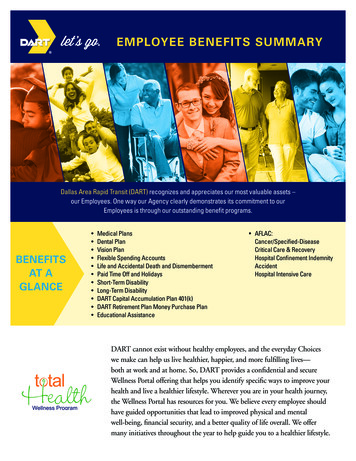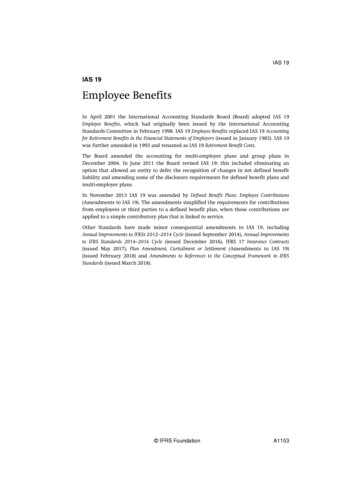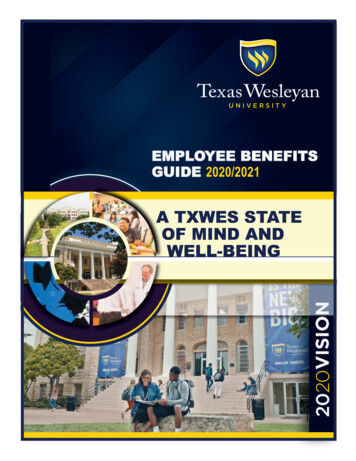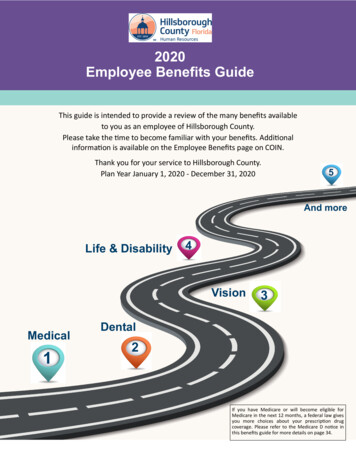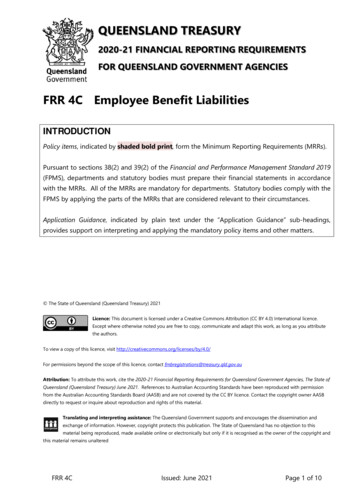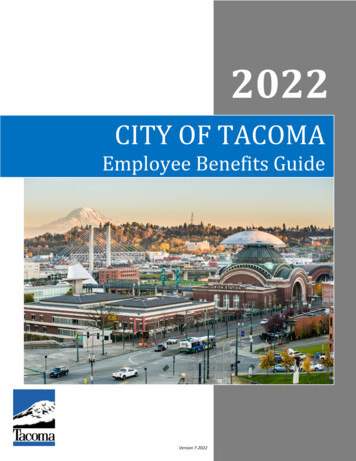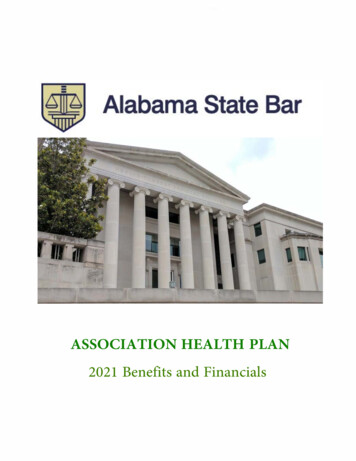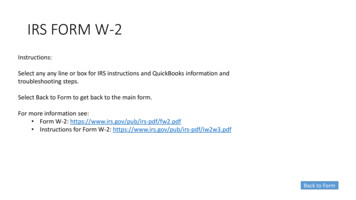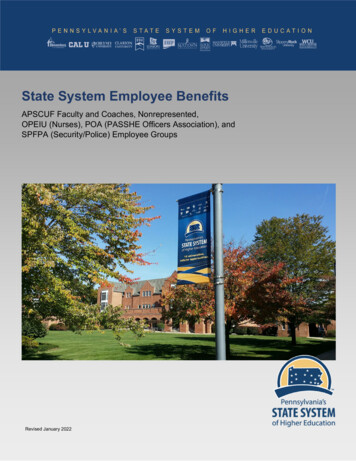
Transcription
State System Employee BenefitsAPSCUF Faculty and Coaches, Nonrepresented,OPEIU (Nurses), POA (PASSHE Officers Association), andSPFPA (Security/Police) Employee GroupsRevised January 2022
State System Employee Benefits–A Comprehensive PackageThe Pennsylvania State System of Higher Education provides a comprehensivepackage of employer benefits to eligible employees and their enrolleddependent(s), which include*: Medical and prescription drug benefits.Generous retirement plans, two options: Alternative Retirement Plan (ARP) State Employees’ Retirement System (SERS)Tuition benefits for employees and dependents.Paid time off (holidays, annual leave, sick leave, personal leave).Employer-paid dental and vision benefits.Employer-paid life insurance.Voluntary insurances and additional retirement programs.*Specific benefits may vary based upon university, employee group and/or collective bargaining unit.This summary highlights the health and prescription drug benefits, supplementalbenefits, retirement benefits, leave entitlement, and other voluntary benefitprograms for State System Employees covered by APSCUF Faculty andCoaches, Nonrepresented, OPEIU, POA, and SPFPA Employees. The benefitsdescribed are available to most employees; however, certain eligibilityrequirements must be met.Information is provided for general purposes only. Legal Plan Documents andthe collective bargaining agreements will govern any discrepancies that mayarise. For additional information concerning these benefits, contact your humanresource office. Benefits, benefit levels, and eligibility rules are subject tochange.Summary of BenefitsEligibility2Health Plan Coverage3Prescription Drug4Dental/Vision CoverageContribution Rates5Effective/End Dates6Flexible Spending Account7Group Life InsuranceVoluntary Life InsuranceAccident Insurance8Long Term DisabilityPaid Time Off9Retirement Programs10Voluntary RetirementTuition WaiverRetiree Health Care11Additional Information12Important Dates and InformationOpen EnrollmentSpring - Health CareHealth plan enrollment changes made during open enrollment are effective July 1.Fall - Flexible Spending Accounts (FSA)FSA enrollment elections made during open enrollment are effective January 1 of the following year.Make changes to your existing coverage. Elect, drop, or change coverage/add or remove dependents. Enroll in a Flexible Spending Account (Healthcare or Dependent Care) for pre-tax savings.Elections should be completed through Employee Self-Service (ESS) at https://portal.passhe.edu/irj/portal.Upon login, click Employee Self-Service, then Benefits, lastly select Benefits Enrollment.Reminder: If you make any changes to your current coverage during Open Enrollment, you mustretain a copy of your benefits election email confirmation. In the event that there is any discrepancywith your enrollment, you will be required to present the email confirmation to the human resourcesoffice.1
Health Plan EligibilityEmployee EligibilityTo be eligible for coverage under the State System health plan, you must be a permanent, full-time employee (includingtemporary, full-time faculty with at least an academic year contract) or a permanent, part-time employee (includingtemporary, part-time faculty with at least an academic year contract) who is scheduled to work every pay period for atleast 50% of full-time.Dependent EligibilityDependents with other coverageThe following categories of individuals may be eligiblefor coverage under the State System health plan foractive employees: Legal spouse Same-Sex Domestic partners, see DependentEligibility for more information. If your spouse is also a State System employee or anannuitant eligible to participate in either active coverageor the Annuitant Health Care Program (AHCP), he orshe may enroll as a single subscriber under his/her ownplan, or as a dependent under the active employee’scoverage, but not both. Likewise, dependents may onlybe covered under one active group plan or AHCP plan.Children under 26 years of age who meet thefollowing requirements: A natural child of your own. A legally adopted child (including a child livingwith the employee during the probation period). A stepchild. A minor child for whom the employee is thecourt or agency appointed legal guardian, asevidenced by the court or agency orderestablishing guardianship. A child over the age of 18, for whom theemployee was the child’s court or agencyappointed legal guardian prior to the child’s18th birthday. A newborn child of an employee isautomatically covered from the moment of birthto 31 days after the date of birth. To be coveredas a dependent beyond the 31-day period, thenewborn child must be added as a dependentthrough the university human resources officewithin 60 days from date of birth.If your spouse is covered under the PennsylvaniaEmployees Benefit Trust Fund (PEBTF), the employeeand dependents may be enrolled on each other’spolicies for the purpose of coordination of benefits.If your spouse is eligible for employer coverage throughhis/her employer, the following rules apply based onyour date of employment:For Employees Hired PRIOR to July 1, 2013Spouses added to coverage after July 1, 2001 who areeligible for fully-paid employer coverage (e.g., noemployee contribution for coverage) through theiremployer must be enrolled in their employer’s coverageand State System health coverage will provide benefitsas secondary payer only.For Employee Hired ON OR AFTER July 1, 2013If an employee enrolls a spouse in the State Systemhealth plan and that person is eligible for coverage undertheir own employer’s plan, the spouse shall be requiredto enroll in their own employer’s plan for their primarycoverage as a condition for eligibility for secondarycoverage under the State System health planregardless of the cost to the spouse for that coverage.Unmarried dependent child 26 years of age orolder, who is incapable of self-support becauseof a physical or mental disability thatcommenced before the age of 26.To view a detailed description and definition ofdependent eligibility, see the Dependent Eligibilityattachment.Dependent DocumentationIn order for dependents to be enrolled in coverage,applicable dependent documentation must be providedwithin the specified time requirements. View theEmployee Responsibilities - Qualifying Eventsattachment for information on how long you have toenroll dependents.Also, view the Dependent Documentation attachment forrequired documentation needed to enroll dependents.2
Health Plan CoveragePreferred Provider Organization (PPO)Applicable plan deductibles, coinsurance, and copays are determined by your employee group. Review the informationbelow for more information.For additional details and information visit the State System websites:- Nonrepresented, OPEIU, POA, SPFPA - PPO- APSCUF Faculty and Coaches - PPONonrepresented, OPEIU, POA, SPFPAAPSCUF Faculty and twork 250 per person, 500 per family 500 per person, 1,000 per family 400 per person, 800 per family 800 per person, 1,600 per family10%30%n/a20% 1,000 per person, 2,000 per family 2,000 per person, 4,000 per familyn/a 3,200 per person, 6,400 per familyPrimary CarePhysician OfficeVisit* 15 copay30% after deductible 20 copay20% after deductibleSpecialist OfficeVisit* 25 copay30% after deductible 30 copay20% after deductibleUrgent Care* 25 copay30% after deductible 50 copay20% after deductibleEmergency Room 100 copay(waived if admitted) 100 copay(waived if admitted) 200 copay(waived if admitted) 200 copay(waived if admitted)Preventive Care*Plan pays 100% no deductible30% after deductiblePlan pays 100% no deductible20% after deductibleDeductibleMember CoinsuranceOut-of-PocketMaximum*Not subject to deductible or coinsurance.Hearing BenefitsEnrollment is included with your health plan election. In order to receive hearing benefits, you must be enrolled in anactive health plan.Hearing Coverage Summary 1,250 per ear (maximum of 2,500 for 2 ears) every 36 months.Preventive CareThere are no member costs for preventive care at in-network providers–the plan pays 100% of the costs forqualifying preventive services. By following the recommendations in the preventive schedule, you may be able toeither prevent certain medical conditions, or detect them before they become more serious.Take a moment to review the preventive schedule and, if needed, contact your medical provider to obtain anyrecommended services.If your medical provider orders diagnostic tests/screenings that are not covered on the preventive schedule, thoseservices may be subject to additional costs (e.g. Deductible and/or coinsurance)3
Prescription Drug CoverageEnrollment in prescription drug coverage is included with your health plan election. Below are the copay amounts. Fordetailed information, view the prescription drug coverage summary. To view the prescription website, click here.Retail Copay(30-day supply) 10Mail-Order Copay(90-day supply) 20Brand Drugs, Formulary 30 60Brand Drugs, Nonformulary 50 100Prescription Drug TierGenericCertain prescription drugs are subject to prior authorization requirements, quantity level limits, or other managementprograms to ensure that these medications are being used in a safe and effective manner, and to help both you and thehealth plan control costs.If you are taking a prescription drug in one of these drug classes, you may receive a letter from Highmark advising you ofany additional requirements with which you or your medical provider may need to comply.Managed Rx Coverage ProgramThe managed prescription drug coverage (MRxC)program consists of online edits that encourage the safeand effective use of targeted medications to meet theclinical needs of members. To better manage the risingcost of these medications, the MRxC program alsopromotes the use of lower cost brand and genericmedications. Many of the criteria are automated in orderto reduce the administrative burden on physicians and toreduce member disruption.Specialty Medication informationIf you or a covered family member need(s) to take aspecialty medication, you will need to obtain theprescription from Walgreens Specialty Pharmacy, a mailorder pharmacy provider solely focused on specialtymedications.Walgreens Specialty Pharmacy has negotiated withHighmark to provide the deepest discounts on specialtymedications, which can average 5,000 or more in costper month. Additionally, this vendor offers a dedicatedcare coordinator to provide support to patients. Foradditional questions or concerns, contact WalgreensSpecialty Pharmacy at 1-888-347-3416.Managed Prior Authorization ProgramCertain medications will require prior authorization toensure the medical necessity and appropriateness of theprescription order as defined by Highmark priorauthorization policies. The member’s prescriber mustobtain authorization from the Plan, prior to dispensingthe medication by a retail pharmacy or through mailorder, if applicable, otherwise the medication will not becovered by the Plan.What is a specialty medication?Specialty medications are used to treat chronic, rare,or complex conditions (such as rheumatoid arthritis,multiple sclerosis, or cancer). Additionally, specialtymedications may:- Be given by infusion, injection, or taken orally.- Cost more than traditional medications.- Have special storage and handling requirements.- Need to be taken on a very strict schedule.- Have support programs and services available tohelp patients receive the most benefit from theirmedication.Step Edit ProgramGeneric medications can reduce prescription cost, andincrease medication adherence while providing the samebenefits as the brand name medication. This policydefines the criteria under which coverage for a brandname medication will be considered when genericproducts are available within the same therapeutic class.Medications targeted in program are used to treat acidreflux, cholesterol, and depression.4
Dental and Vision CoverageOffered at no cost to the employee.Coaches, Nonrepresented, OPEIU, POA, SPFPAAPSCUF FacultyDental Plan Information – click here.Benefits currently administered by United Concordia(UCCI) 1,250 maximum benefit per calendar year per person(Orthodontics have a separate maximum)Dental and vision benefits provided by the PennsylvaniaFaculty Health and Welfare Fund. For additionalinformation contact the Fund Administrator at 844-8651137 or via email at pafaculty@cdsadmin.comVision Plan Information – click hereBenefits currently administered by National VisionAdministrators (NVA) Routine exam, standard lenses, and progressivelenses paid in full Frames - 50 allowance towards wholesale price Contact lenses and low vision aids based on aschedule of allowancesEmployee Contribution RatesTo view the current health plan employee rates, click here. These rates include coverage for health, prescription drug, andhearing benefits.Dental/Vision offered at no cost to the employee.Healthy U Wellness ProgramEmployees can pay substantially lower health care contribution ratesif they participate in the Healthy U wellness program. Employees(and enrolled spouses) must complete the Healthy U requirementseach program year to be eligible for the reduced premium rates.Participation in the Healthy U Wellness Program also carries with itmany other rewards. In the long run, the payback in terms of yourimproved well-being will likely be far more significant than thecontributions you saved.For additional information view the Healthy U website.Premium Conversion PlanHealthy U DeadlineEmployees must complete the Healthy Urequirements by May 31 of every year.If you are hired/enrolled on or after April 1,you will automatically be placed in theparticipating rate and do not need tocomplete the participation requirementsuntil the next wellness plan year thatbegins July 1.Allows employees who are contributing to the cost of health care to pay those contributions on a pre-tax basis, resulting inhigher net take-home pay. All employees enrolled in a health care plan and contributing toward the cost of that plan areenrolled.5
Health Plan Coverage Effective Dates:Coverage for you and your dependents begins on:- Date of employment or;- Date you become eligible.You must enroll on a timely basis. View the chart below and the Employee Responsibilities – Qualifying Eventsattachment for additional information/direction on how long you have to enroll after qualifying events.EventDate of employment ordate you become eligibleMust Elect WithinEffective Date30 days of employment or eligibilityFirst day of employment or eligibilityOpen enrollmentApplicable open enrollment datesJuly 1 of the following yearMarriage60 days of the marriageDate of marriageNewborn*60 days of birth*Date of birth*Loss/Gain in coverage60 days of eventDate of loss/gain*A newborn child will be covered under the plan for 31 days following birth. Coverage will not continue beyond 31 days unless anenrollment form is completed within 60 days.If eligible dependents are not added to your health plan within 60 days of the event or within 60 days from the date thateligibility under other coverage ended, those dependents may not enroll until the next open enrollment period for aneffective date of July 1. View the Employee Responsibilities - Qualifying Events attachment for information on how longyou have to enroll dependents.Health Plan Coverage Ending Dates:Eligibility ends when: You terminate employment or are furloughed; You regularly work less than 50 percent of full-time; You retire, or You die*EventMust Drop ByLong-term unpaid leave of absencen/aDate eligibility endsn/aCoverage Endswhen benefits entitlement on leaveendsDate of eligibility lossDivorced spouse60 days within divorceDate of divorceDependent child reaches age 26Automatically dropped from coverageLast day of the monthFailure to pay premiumsn/aLast date paid*In the event of an employee death for an APSCUF faculty or coach, coverage for enrolled dependents may be extendeduntil the end of the month or until the 14th of the following month, depending on the date of death.ON THE DAY YOUR COVERAGE ENDS, IT IS ILLEGAL TO USE YOUR IDENTIFICATION CARDS. PLEASEDESTROY THEM IMMEDIATELY. IF YOU OR A DEPENDENT(S) DO USE YOUR CARDS, YOU WILL BE CHARGED.6
Flexible Spending Accounts (FSA)Available to full-time permanent employees and permanent part-time employees who work at least 50% time, includingtemporary faculty employed for a one-academic year contract, who work 50% time. Flexible spending accounts (FSAs)governed by the IRS Code, allow employees to have income withheld from their paychecks before taxes for eventualreimbursement of certain medical and dependent care expenses.Health Care FSADependent Care FSAThis type of FSA is for daycare or elder care expenses,including before/after school care and summer daycamps.Enrolling in the health care FSA can help you savemoney on your deductible, coinsurance, or otherqualifying medical costs. You contribute money fromyour paycheck on a pre-tax basis, and get reimbursedfrom your FSA account as you incur eligible expenses.Please note: Dependent care is not for health careexpenses for your dependents.Financially, this helps you in two ways:1. Your entire health care FSA election amount isimmediately available to you at the beginning ofthe year to pay for qualifying expenses.2. You will reduce your taxes by participating in anFSA, potentially saving you hundreds of dollarsa year (depending on the amount of your FSAelection and your tax bracket).You may use your Dependent Care FSA to receivereimbursement for eligible dependent care expenses forqualifying individuals, which includes a tax dependent12 years or younger, or a spouse or other taxdependent of any age who is physically and/ormentally incapable of self-care. Only the custodialparent of divorced parents can be reimbursed using aDependent Care FSA.Eligible expenses for reimbursement includecoinsurances, deductibles and amounts in excess ofplan allowances or maximums, prescription drugcopayments, PPO and HMO doctor office visit charges,lasik eye surgery, orthodontia, chiropractic services, etc.Dependent care funds are available to you ascontributions are made to the account. Unlike a HealthCare FSA, the entire maximum annual amount is notavailable during the plan year, but rather after yourpayroll deductions are received.Maximum annual contribution is 2,750Maximum annual contribution is 5,000Carryover ProvisionUp to 570 of your unused health care FSA dollars canbe carried over into the next plan year.The carryover provision does not apply to theDependent Care FSA.Along with the carryover provision, State Systememployees have the opportunity to submit expenses thatwere incurred in the previous plan year in the firstthree months of the following plan year (called a run-outperiod).HSA ReminderThe State System does not offer an HSA plan but if your spouse is enrolled in an HSA plan offered by their employer,this may impact your FSA enrollment. A health savings account (HSA) is available to an eligible individual who has highdeductible health coverage as long as the individual has no other impermissible health coverage. A general purposeFSA is impermissible and renders an individual ineligible to make contributions to an HSA even when it’s theirspouse enrolled in a general purpose FSA.Annual EnrollmentThe FSA plan requires an annual enrollment. Even if you enrolled in an FSA in the current year, you must annually electto participate in subsequent years.Visit the FSA website and review the FSA Handbook for more information about flexible spending accounts, including a list ofeligible expenses and an interactive contribution and tax-savings calculator. To speak with an FSA specialist, call 1-877-2924040.7
.Additional Insurance CoverageGroup Life InsuranceThe State System enrolls all permanent employees in our group life insurance program at no cost to the employee. Theamount of term life insurance is equal to the nearest 1,000 of basic annual salary, up to the applicable maximum.Maintain your account and keep your beneficiary designation up to date with MetLife at www.metlife.com/mybenefits.Coverage AmountAdditional Work-RelatedAccidental DeathCoverageAge Based ReductionsNonrepresented, APSCUFFaculty and Coaches1x salary up to amaximum of 50,000 20,000N/AOPEIU1x salary up to amaximum of 40,000 25,000Reduced at age 70 to 65%;age 75 to 50%POA, SPFPA1x salary up to amaximum of 40,000 25,000Reduced at age 70 to 65%;age 75 to 50%Union 90-day waiting periodRight to convert upon termination/retirementVoluntary InsurancesThe following insurance programs are available to all permanent full-time employees (including temporary, full-time facultywith at least an academic year contract), or permanent, part-time employees (including temporary, part-time faculty with atleast an academic year contract) who are scheduled to work every pay period for at least 50 percent of full-time. Theseprograms are administered by New York Life.Voluntary Group Life Insurance (VGLIP)VGLIP provides life insurance coverage to help your family cover your final expenses, including funeral costs – NewYork Life insurance helps your family during a difficult time by providing additional financial resources when they needit most.Benefits elected within the first 31 days of eligibility will be issued without evidence of good health (subject toapplicable coverage limits). If you wish to elect at any other time or elect coverage in excess of the guaranteed issuelimits, evidence of good health will be required.To view additional details including rate information, visit the VGLIP website or summary.Coverage OptionsEmployeeSpouseChild(ren)*Elect in increments of 10,000 5,000 5,000 or 10,000Guaranteed Coverage 150,000 25,000 10,000*One premium covers all children, regardless of the number of children you have.8Maximum Coverage5x Salary or 500,000 100,000 10,000
Accident Death and Dismemberment Insurance (AD&D)AD&D insurance can help protect families from financial hardship by paying a benefit upon death or serious injury dueto a covered accident. Benefits can only be elected within the first 31 days of eligibility.To view additional details including rate information, visit the AD&D website or summary.Coverage OptionsEmployeeSpouseChild(ren)*Elect in increments of 10,000 10,000 5,000 or 10,000Maximum Coverage5x Salary or 500,000 250,000 10,000*One premium covers all children, regardless of the number of children you have.Voluntary Long-Term Disability Insurance (LTD)LTD insurance is income protection which pays up to 60% of gross annual base salaryto a maximum of 5,000 monthly benefits. The amount may be offset by other incomesources such as retirement benefits, workers’ compensation, social security, and paidleave with a guarantee of 10% of long-term disability benefit amount or 100/month,whichever is greater.Benefits elected within the first 31 days of eligibility will be issued without evidence ofgood health. If you wish to elect at any other time, evidence of good health will berequired.Additional NewYork LifeBenefitsEnrollment in VGLIP,AD&D, or LTD comewith additionalbenefits offered byNew York Life, suchas identify theftprotection and willpreparation. To viewthose benefits, seethe VoluntaryInsuranceAttachment.To view additional details including rate information, visit the LTD website or summary.Coverage OptionsOption 1Option 2Waiting Period180-day waiting period90-day waiting periodPaid Time OffLeave benefit entitlements are determined by your employee group. Click the employee group below for more details:- APSCUF Faculty- APSCUF Coaches- Nonrepresented- OPEIU Nurses- POA, SPFPA Security/PoliceHolidays: Observation of holidays varies by university. Contact your Human Resources office for details.9
Retirement ProgramsThe following plans are available to employees hired on/after January 1, 2019. Current employees can find information ontheir plan at www.passhe.edu/retirement.EligibilityEnrollment in the retirement program is required, effective the first day ofemployment as a permanent full-time or part-time employee. Temporaryemployees must enroll in the retirement program once they have worked 750hours in a calendar year.Newly eligible employees have 30 days from their eligibility date to decidewhich retirement plan is best for them, the Alternative Retirement Plan (ARP)or the State Employees’ Retirement System (SERS).Campus PoliceThere are a few exceptionsrelated to campus police includingpatrol officer, police specialist,police supervisor, police chief, orassistant police chief. View thecampus police retirement page foradditional information.If you do not select a retirement plan within 30 days, you will automatically beenrolled in the SERS Class A5 hybrid plan. Once enrolled in a retirement plan,that enrollment is irrevocable, meaning you must remain in that retirement plan for the duration of your employment, evenif you leave employment with the State System and return to work later.View the summary of information below and additional information at www.passhe.edu/retirement.PlanEmployee ContributionEmployer ContributionAlternative Retirement Plan5%9.29%SERS Class A5 Hybrid Plan8.25%2.25% Pension Fund Calculation*SERS Class A6 Hybrid Plan7.5%2% Pension Fund Calculation*SERS Class 40 – Investment Plan7.5%3.5%*The pension plan employer contribution is calculated each year based on assets and liabilities of SERS pension fund.Alternative Retirement Plan (ARP)The ARP is a defined contribution plan. Your retirement income isdetermined by your account balance at the time of retirement, which iscomprised of your employee contributions (5% of salary), the employercontributions (9.29% of salary), and any earnings based on theperformance of your investments.Employee5%Employer9.29%Participants are 100% vested from their date of enrollment, which means from the date the monies are deposited into yourARP account, they are yours to keep. If you were to leave employment, regardless of how long you were employed, theentire investment account balance belongs to you. The ARP account is also portable, meaning if you leave employmentbefore retirement, you can rollover those monies into a new employer’s retirement plan, or into a different retirementaccount such as an IRA.Employees contribute 5% of their pay on a pre-tax basis each pay period, while the State System contributes almost twicethat amount - 9.29% as the employer contribution each pay period.10
State Employees’ Retirement Plan (SERS)Under the SERS umbrella, there are three different plan options. If you select SERS as your group retirement plan, you areautomatically enrolled in the Class A5 hybrid plan. After enrollment, you will be contacted by SERS and given 45 days tomake a one-time election to switch to Class A6 or the Straight Defined Contribution/Investment Plan.If you are enrolled in Class A5 or A6 hybrid plans, your retirement benefit comes from two plans: Pension plan that features guaranteed monthly payments and;Investment plan where the amount of money is based on contributions by you and your employer, along withpersonal investment choices and the markets.If you are enrolled in the Straight Defined Contribution plan your account balance at the time of retirement is comprised ofyour employee contributions, employer contributions, and any earning based on the performance of your investments.Participants do not become vested for the employer contributions until you have worked 10 years for the pension plan and 3years for the investment plan. That means if you’re no longer employed by the State System before fully vested, you onlyhave the right to your contributions and interest. You also do not have a right to monthly pension payments.Voluntary Retirement PlansThe State System offers two additional options to save and invest extra money for retirement. Whether you aresupplementing your group retirement plan or you are not eligible to enroll in the group retirement plan, the voluntaryretirement plans are available to all employees upon their date of hire. Employees can choose to contribute up to theannual IRS limits in both plans. There are no employer contributions for these plans.To view the IRS limits and differences between the 457(b) and 403(b) plans, view the Voluntary Plan ComparisonDeferred Compensation – 457(b) Plan Tax Sheltered Annuity (TSA) - 403(b) Plan . Employees are able to choose from TIAA and/or Fidelityas their TSA vendor and choose from the same coreinvestment lineup as the ARP retirement plan, offered atthe lowest possible fee structure. Access to a brokeragewindow is available for employees who desire investmentchoices outside of the core lineup with TIAA and/orFidelity.The 457(b) Plan offers a simple, flexible way for you tosave for retirement. With its powerful pretax and Rothsaving features, investment options and planningresources, you can work toward replacing your workingincome in retirement - for life. Review the 457(b) Planhighlights document to see how the 457(b) Plan can helpyou save, invest and prepare for retirement.To enroll complete a paper form or register online under "Ihave a plan enrollment code" (Enter your Group ID 9897801 and Plan Enrollment Code found here.)To enroll, log on to the Retirement@Work TSA website.Click the links below for more information and to getstarted.Empower Retirement WebsitePlan HighlightsRetirement@Work User GuideRetirement@Work WebsiteVisit www.passhe.edu/enrollTSA to enroll in the plans above.Tuition WaiverTuition waiver benefit varies by employee group. View your applicable collective bargaining agreement and/or universitypolicy for additional information regarding your benefit. Contact your human resources office for more information.Retiree Health CareNonrepresented, POA, SPFPA, and OPEIU employees hired prior to January 16,
employee contribution for coverage) through their employer must be enrolled in their employer's coverage and State System health coverage will provide benefits as secondary payer only. For Employee Hired ON OR AFTER July 1, 2013 . If an employee enrolls a spouse in the State System health plan and that person is eligible for coverage under
